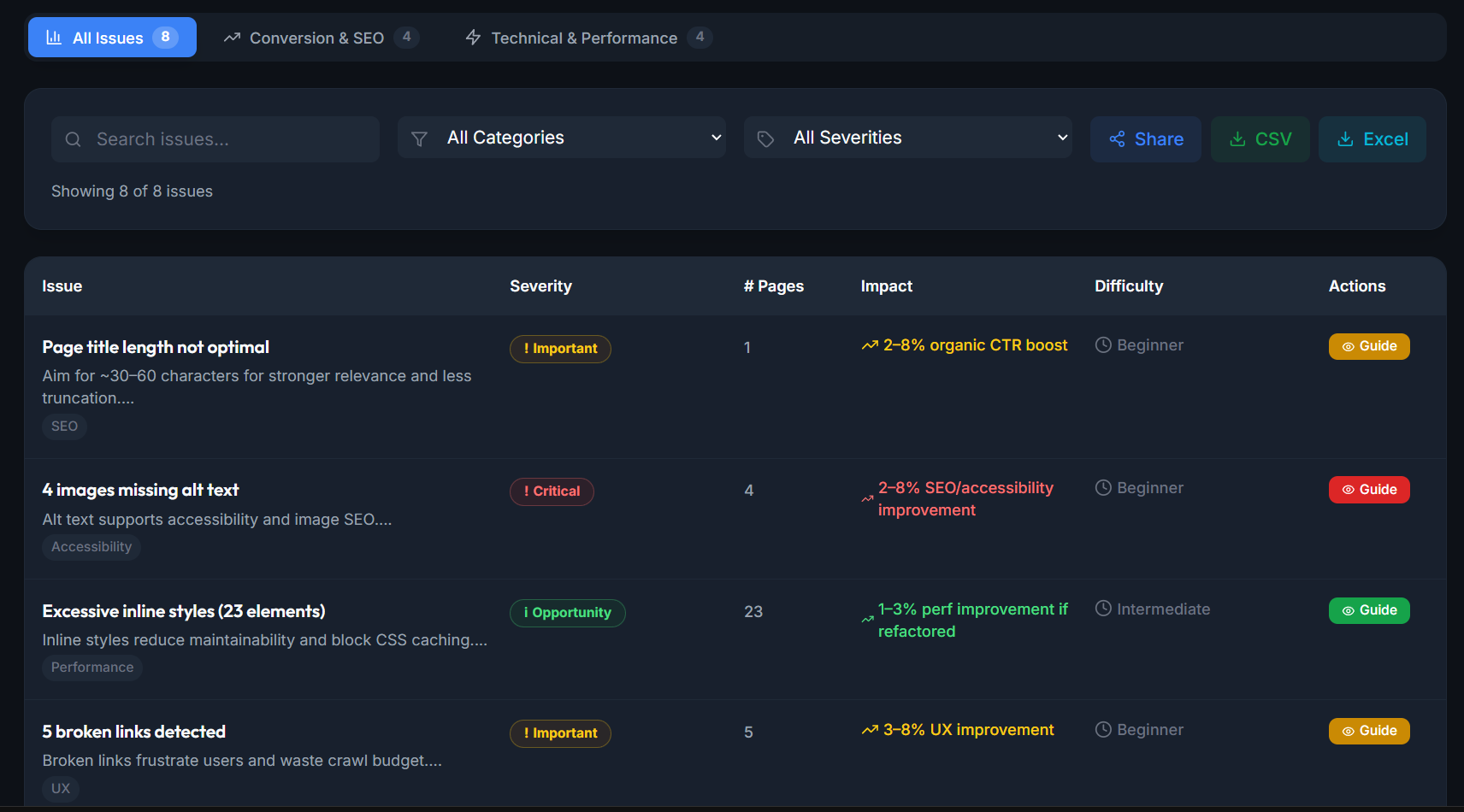Microsites are small, focused websites created for specific purposes like promoting a product, brand, or event. They are designed to drive targeted traffic and test new ideas. While microsites can be effective, there are several significant disadvantages to consider.
From SEO challenges and traffic cannibalization to high costs and ongoing maintenance, microsites can often create more problems than they solve. Additionally, they may dilute your brand’s identity instead of enhancing it.
What is a Microsite?
A microsite is a small, focused website designed to promote a specific product, brand, or event. Unlike larger websites, microsites are streamlined to target a niche audience, making them a powerful tool for creating a specialized online presence.
Because they are typically smaller and more focused, microsites are often easier and cheaper to create. They are also great for testing new ideas or designs before adding them to your main site.
7 Disadvantages of Microsites in Web Design
Our web design and SEO company has listed several disadvantages when using a microsite. The following are 7 of the most powerful disadvantages you should consider:
1. Microsites can cannibalize traffic from the main pages:
- Microsites can divert traffic away from the main website. Since they are often more focused and appealing, users might spend more time on the microsite than the main site, leading to decreased traffic and conversions on the primary website.
TIP: To prevent traffic cannibalization, ensure the microsite complements the main website rather than competes with it. Link back to the main site frequently and use consistent branding to encourage cross-navigation.
Example: A company promoting a new product via a microsite can include links to related products and blog articles on the main site, guiding users back to the primary platform for more information.
-------------------------------------------------------
2. Can be difficult to optimize for search engines:
- Microsites are typically smaller in scope, making it challenging to optimize them for desired keywords and phrases. They often struggle to rank well for general terms, which can limit their visibility in search engine results.
TIP: Focus on niche keywords specific to the microsite’s content and ensure proper on-page SEO practices. Use backlinks from the main website and other reputable sources to improve authority and ranking.
Example: An event-based microsite can target specific keywords like “annual tech conference 2024” instead of broader terms, and incorporate backlinks from the main company site’s event section to boost SEO.
-------------------------------------------------------
3. Can be costly & time-consuming to create or maintain:
- Creating and maintaining a microsite can be costly and time-consuming. Although they are smaller than main websites, they require significant design, development, and frequent updates, adding to overall costs.
TIP: Use templates or modular design systems that allow easy updates and lower development costs. Plan the microsite lifecycle to determine when it can be merged back into the main site.
Example: A seasonal sales microsite can be created using a flexible template that allows quick modifications for future sales events, reducing the need for a complete rebuild each time.
-------------------------------------------------------
4. May not provide the same branding and identity benefits:
- Unlike a traditional website, microsites focus on specific campaigns or topics and may not fully convey a company’s brand identity. This narrow focus can dilute overall brand messaging and reduce the benefits of a unified online presence.
TIP: Ensure the microsite’s design and messaging align closely with the main brand, using consistent logos, colours, and tones. Include a clear path for users to explore the broader brand story.
Example: A microsite for a new product launch should feature the same visual style and messaging as the main brand, with links to a “Learn More” page that explains the company’s values and history.
-------------------------------------------------------
5. Confusing if you aren't familiar with the company's web presence:
- Visitors unfamiliar with the company's web presence might find microsites confusing. Since they are standalone websites, navigating them without context from the main site can be challenging, making it harder to provide a cohesive overview of the brand.
TIP: Integrate clear navigation cues and links to the main website to help users find their way. Include a “Back to Main Site” button or similar navigation aids prominently.
Example: A microsite dedicated to a specific campaign can feature a top navigation bar with direct links to the main site’s homepage and other key sections, ensuring a seamless user experience.
-------------------------------------------------------
6. Difficult to manage if they are not part of the main website's structure:
- Microsites that aren't integrated into the main website's structure can be hard to manage. They may complicate content updates and risk creating duplicate content, which can negatively impact user experience and SEO.
TIP: Use a centralized content management system (CMS) that allows easy updates across both the main site and microsites. Regularly audit content to avoid duplication and ensure consistent messaging.
Example: A business using multiple microsites for different regions can manage all content from a single CMS, ensuring all sites are updated simultaneously and maintaining a consistent brand voice.
-------------------------------------------------------
7. May not take advantage of the main website's existing traffic:
- Microsites often miss out on leveraging the main website's existing traffic as they are hosted separately, they rely solely on their marketing efforts, which can be a significant disadvantage, especially for new businesses trying to build an audience. Also, their separate domains can make it harder to rank for keywords.
TIP: Link the microsite to the main website through strategic calls-to-action (CTAs) and cross-promotion. Consider hosting the microsite as a subdomain or directory of the main site to leverage existing SEO authority better.
Example: A company launching a new product microsite can host it as a subdomain (e.g., product.example.com) and use CTAs on the main site’s homepage to drive traffic to the microsite, maximizing visibility and engagement.
7 Benefits of Building a Microsite
Building microsites can have both pros and cons, but when used strategically, they can offer several advantages to enhance your web presence and marketing efforts.
1. Better target a particular audience:
- Microsites are highly focused and tailored, making them ideal for targeting specific audiences or demographics. By honing in on a particular topic, product, or campaign, microsites can attract and engage users who are most likely to convert into customers or leads.
Example: A fitness brand launching a new line of supplements can create a microsite dedicated to fitness enthusiasts, featuring tailored content and promotions that appeal specifically to this audience.
-------------------------------------------------------
2. Help you launch a new product or service:
- Microsites are an excellent platform for launching new products or services. They allow businesses to create dedicated spaces highlighting new offerings and generating buzz without overhauling the main website. Microsites also offer a controlled environment for testing new ideas and gathering feedback before a full-scale launch.
Example: A tech company introducing a new gadget can use a microsite to showcase the product’s features, offer pre-orders, and collect customer feedback to refine its marketing strategy.
-------------------------------------------------------
3. Better measures web traffic and conversions:
- Microsites make it easier to track specific metrics, such as visitor numbers, source of traffic, and conversion rates, allowing for more precise measurement of marketing campaigns. This focused data collection helps businesses understand what works best and optimize accordingly.
Example: A company can use analytics tools on a microsite to track how users interact with a promotional campaign, then adjust their main site’s content and SEO strategy based on these insights.
-------------------------------------------------------
4. Builds your brand:
- Microsites provide a unique platform to build and reinforce your brand. By creating a specialized web presence, you can differentiate yourself from competitors and enhance brand recognition and awareness. Microsites allow for creativity and experimentation in ways that might not be suitable for your main website.
Example: A cosmetics brand could use a microsite to host an interactive campaign highlighting their commitment to sustainability, thereby strengthening their brand’s image as eco-friendly and socially responsible.
-------------------------------------------------------
5. Generate leads:
- By focusing on specific campaigns, microsites can drive traffic to targeted landing pages where visitors can easily provide their contact information. This makes microsites an effective tool for lead generation, especially when targeting visitors who are interested but not yet ready to make a purchase.
Example: A financial services company can create a microsite offering a free e-book on investment strategies, capturing leads from users who download the material.
-------------------------------------------------------
6. Increase sales:
- Microsites are designed with clear calls to action, such as encouraging purchases or sign-ups, which can lead to higher conversion rates. Their focused content and user-friendly layout make them effective at guiding visitors toward taking specific actions.
Example: An online retailer can create a holiday sales microsite with special offers and limited-time discounts, directly driving sales and increasing revenue during peak shopping seasons.
-------------------------------------------------------
7. Improves SEO search engine ranking:
- Microsites can enhance SEO efforts by targeting specific keywords and creating rich, relevant content around them. This focus helps microsites rank higher for those keywords in search engine results. Additionally, well-designed microsites can generate valuable backlinks, further boosting SEO.
Example: A travel agency could build a microsite around a popular travel destination, filling it with keyword-rich content and links back to their main site’s booking pages, thereby improving overall search engine visibility.
-------------------------------------------------------
10 Creative Microsite Examples for Target Audience
Here are ten standout microsite examples curated by our web design and SEO experts, each showcasing innovative ways to connect with specific target audiences:
1. The New York Times Magazine: Walking New York
This microsite combines stunning visuals with an interactive storytelling experience, captivating readers by taking them on a virtual walk through New York City. It effectively engages its audience with a unique mix of multimedia content that highlights the city's vibrant street culture.
- Interactive Storytelling: The microsite features a dynamic blend of multimedia, including videos, photos, and text, creating an immersive storytelling experience.
- Virtual Exploration: Users can navigate through New York City virtually, exploring different neighborhoods and street art in a unique way.
- Stunning Visuals: High-quality images and animations enhance the visual appeal, making the content more engaging and memorable.
2. American Cycling Association: CommUtah
Designed to promote cycling events in Utah, this microsite uses bold imagery and easy navigation to appeal to cycling enthusiasts. The site’s focused content and streamlined design make it a go-to resource for information about upcoming rides and races.
- Event-Focused Content: The microsite is dedicated to providing detailed information about cycling events in Utah, catering specifically to cycling enthusiasts.
- Bold Imagery: Striking photos and videos of cyclists and Utah's landscapes attract attention and inspire participation.
- Easy Navigation: A user-friendly interface allows visitors to quickly find event details, routes, and registration information.
3. Adobe: My creative type
Adobe’s “My Creative Type” microsite engages users through a fun, personality-based quiz that reveals their creative style. This interactive experience not only entertains but also reinforces Adobe’s brand identity as a leader in creative software.
- Personality Quiz: The microsite features an engaging quiz that helps users discover their creative style, making the experience personalized and fun.
- Shareable Results: Users can easily share their quiz results on social media, increasing the site's reach and engagement.
- Visual and Interactive Design: The microsite uses vibrant graphics and animations to reflect the creativity of Adobe’s brand, enhancing the user experience.
4. Dumpark: The seas of plastic
“The Seas of Plastic” microsite uses visuals and compelling data to raise awareness about ocean pollution. By focusing on a single environmental issue, this site effectively educates visitors while encouraging them to take action.
- Impactful Visuals: The site uses dramatic images and infographics to illustrate the scale of ocean pollution, making the issue more tangible for visitors.
- Educational Content: Detailed data and compelling narratives inform users about plastic waste and its effects on marine life.
- Call to Action: The microsite encourages visitors to take action, whether through donations, sharing information, or reducing plastic use.
5. ProPublica: How much is a limb worth
This microsite combines investigative journalism with interactive graphics to explore the human cost of workplace injuries. It effectively engages its audience by providing a deep, immersive experience that highlights important social issues.
- Investigative Reporting: This microsite provides in-depth coverage of workplace injuries, combining storytelling with factual data.
- Interactive Graphics: Users can explore data through interactive charts and maps, enhancing understanding and engagement.
- Personal Stories: The inclusion of real-life stories from injured workers helps humanize the data, creating an emotional connection with the audience.
6. Samsung: Z Flip phone
Samsung’s Z Flip Phone microsite is a sleek, interactive showcase of their foldable phone technology. The site’s dynamic design and engaging animations reflect the innovative nature of the product, drawing in tech-savvy consumers.
- Product Showcase: The microsite highlights the innovative features of the Z Flip phone through engaging animations and demonstrations.
- Dynamic Design: Interactive elements like foldable simulations and 360-degree views allow users to explore the product in detail.
- Seamless Navigation: Easy-to-navigate sections guide users through the phone’s features, benefits, and purchasing options.
7. Lufthansa: As time flies by
Lufthansa’s “As Time Flies By” microsite takes visitors on a nostalgic journey through the airline’s history, using interactive timelines and vintage photos. It’s a great example of how brands can use microsites to strengthen their heritage and connect emotionally with their audience.
- Interactive Timelines: Visitors can explore Lufthansa's history through a timeline that includes key milestones and events.
- Vintage Photography: The use of historical photos creates a nostalgic feel, enhancing the storytelling aspect of the microsite.
- Emotional Connection: By showcasing the brand’s evolution, the microsite connects emotionally with long-time customers and aviation enthusiasts.
8. Tiffany & Co.: Tiffany Blue Book
The Tiffany Blue Book microsite is a luxurious showcase of the brand’s high-end jewellery collection. Its elegant design and interactive features provide an immersive shopping experience, perfectly aligned with Tiffany & Co.'s prestigious image.
- Elegant Design: The microsite features a sophisticated layout with high-quality images, reflecting the luxury of Tiffany’s jewelry.
- Interactive Features: Users can view collections in detail, with zoom functionality and detailed descriptions enhancing the shopping experience.
- Brand Consistency: The microsite maintains Tiffany’s iconic branding through consistent use of color, typography, and style.
9. Nike: Dream Crazy
Nike’s “Dream Crazy” microsite focuses on inspiring stories of athletes overcoming challenges. Through compelling video content and powerful storytelling, the site aligns with Nike’s brand ethos and engages viewers with motivational content.
- Compelling Stories: The microsite features inspiring stories of athletes overcoming challenges, aligning with Nike's motivational brand message.
- Powerful Videos: High-quality video content captures emotional moments, engaging viewers and enhancing the impact of the stories.
- Strong Calls to Action: Clear calls to action encourage visitors to learn more about the athletes, explore Nike products, or share the stories on social media.
10. Spotify’s “Wrapped"
Spotify’s “Wrapped” microsite gives users a personalized recap of their most-listened-to songs and artists over the past year. This interactive experience drives user engagement by allowing users to share their unique music tastes on social media, creating buzz and enhancing Spotify’s community feel.
- Personalized Content: The microsite offers a personalized recap of a user’s listening habits, making the experience unique and engaging.
- Data Visualization: The site uses creative graphics to display users’ music data, making it visually appealing and easy to digest.
- Social Sharing: Features that allow users to share their year-in-music stats on social media encourage user interaction and brand promotion.
Common Features of Microsites
Microsites are powerful tools for targeted marketing and engagement.
Focused and Specific Purpose: Microsites are designed with a clear, specific goal, such as promoting a new product, generating leads, or raising awareness for a campaign. This singular focus helps drive targeted traffic and achieve specific marketing objectives.
Unique Domain Name: A successful microsite should have a unique domain name that is easy to remember and relevant to its content. This separation from the main website helps distinguish the microsite and enhances its visibility.
Distinct Web Design: The design of a microsite should be distinct from the main website to make it stand out. A unique design captures attention and makes the microsite more memorable for visitors, which can be crucial for campaign-specific initiatives.
Limited Content: Content on a microsite should be concise and highly focused, providing only the necessary information to fulfil its purpose. This streamlined approach helps users find what they need quickly, enhancing user experience and engagement.
Consistent Branding and Identity: While microsites should have a unique look, they must also maintain consistent branding with the main website. This helps reinforce brand identity and ensures visitors can easily connect the microsite to the parent brand.
Keyword-Rich Titles: Titles on microsites should accurately reflect the content and include relevant keywords to improve search engine optimization (SEO). This practice enhances visibility and attracts the right audience.
Optimized Content: All content on a microsite should be optimized for search engines and mobile devices. This includes using relevant keywords, creating engaging and informative content, and ensuring a responsive design for mobile users.
Link Building: To improve the search engine ranking of a microsite, it's essential to build quality backlinks from reputable sources. This can be achieved through guest blogging, directory submissions, and active engagement on social media platforms.
Monitoring and Analysis: Regularly monitoring the performance of your microsite is crucial to ensure it meets its goals. Use web analytics tools like Google Analytics to track metrics such as traffic, user engagement, and search engine rankings. Adjust your strategy based on this data to optimize the microsite's effectiveness.
5 Tips To Create A Microsite:
A microsite is a dedicated website designed to promote a specific product, service, or brand. When executed well, a microsite can be a powerful marketing tool that generates leads, builds brand awareness, and drives sales.
1. Keep it focused
The most effective microsites are tightly focused on a specific topic, product, or service. This targeted approach allows you to tailor content to a particular audience, making your message more relevant and impactful. A clear focus also simplifies tracking performance metrics, helping you evaluate the success of your microsite.
TIP: Choose one main objective for your microsite, such as promoting a new product launch, and ensure all content supports this goal.
-------------------------------------------------------
2. Make it visually appealing
First impressions matter, especially online. A visually appealing microsite with high-quality images, engaging graphics, and a clean design can captivate visitors and keep them interested. Additionally, ensure that your microsite is easy to navigate, with intuitive layouts that guide users toward your desired actions.
TIP: Use a consistent colour scheme and design elements that align with your brand, and include plenty of white space to avoid clutter.
-------------------------------------------------------
3. Create compelling content
Your microsite’s content should be engaging, clear, and action-oriented. Write concise copy that conveys your message effectively, and include strong calls to action that encourage visitors to take the next step, whether that’s signing up for a newsletter, downloading a guide, or making a purchase.
TIP: Use a mix of text, images, and multimedia elements to keep content dynamic and interesting, and regularly update the site to keep it fresh.
-------------------------------------------------------
4. Promote microsite
Even the best-designed microsite needs promotion to attract visitors. Utilize a variety of channels, such as social media, email marketing, and paid advertising, to drive traffic to your microsite. Additionally, optimize the microsite for search engines (SEO) to improve its visibility and reach.
TIP: Create a promotional calendar that outlines your strategy for sharing your microsite across different platforms and ensure consistent messaging.
-------------------------------------------------------
5. Measure results
Track the performance of your microsite using analytics tools to monitor key metrics like web traffic, engagement, and conversions. Analyzing this data will help you understand what’s working and what’s not, allowing you to make informed adjustments to improve your microsite’s effectiveness.
TIP: Set specific goals for your microsite and use analytics to measure progress toward these goals. Regularly review and refine your strategy based on these insights.
Microsites vs Landing Pages
1. Microsites are small websites on a separate domain or subdomain from the main corporate site, designed to target specific audiences and promote a particular campaign or product. With a minimal design, microsites focus on a single goal, reducing distractions and effectively guiding potential customers through the sales funnel.
2. Landing pages are single web pages within a larger site, aimed at converting visitors through specific calls to action. While both microsites and landing pages can be shareable, microsites offer a more immersive experience with branded content and unique URLs that enhance visibility and attract organic traffic.
Conclusion - Cons of Microsite
Creating a microsite can be a powerful marketing strategy to enhance your main website's reach and engage specific audiences. To succeed, keep your microsite focused, visually appealing, and filled with compelling content. Promote it through various channels like social media and SEO, and use analytics to measure its performance.
Paid advertising can boost visibility but should align with your goals and budget. Ultimately, a successful microsite depends on targeting the right audience, setting clear objectives, and tracking results to refine your strategy.
Website & Microsite Guide
When Should You Use A Microsite?
Microsites are created when the main goal is to focus on a specific campaign, product, or audience, separate from your main website. They're useful for targeted marketing, launching new products, or promoting events with a unique URL that helps brands create distinct experiences.
How To Manage A Microsite?
To manage a microsite effectively, keep the content updated and relevant to its main goal. Monitor performance using analytics and ensure the microsite’s URL and content align with your overall brand strategy. Regularly optimize for SEO and user engagement to maintain its effectiveness.
Are Microsites Good For Seo?
Microsites can be good for SEO if they are created with unique, valuable content and have a focused URL strategy. When done correctly, microsites can help brands rank for specific keywords and drive targeted traffic. However, they must be managed carefully to avoid diluting SEO efforts.
What Is The Difference Between A Website And A Microsite?
A website provides a comprehensive online presence for a brand or business, covering various topics and goals. In contrast, microsites are created with a specific main goal in mind, such as promoting a campaign or product. They usually have a distinct URL and a focused purpose, which helps brands deliver targeted content to a specific audience.
Are microsites still used?
Microsites are still used, but best reserved for time-boxed campaigns, highly targeted audiences, or experimental storytelling that would clutter your primary website.


















